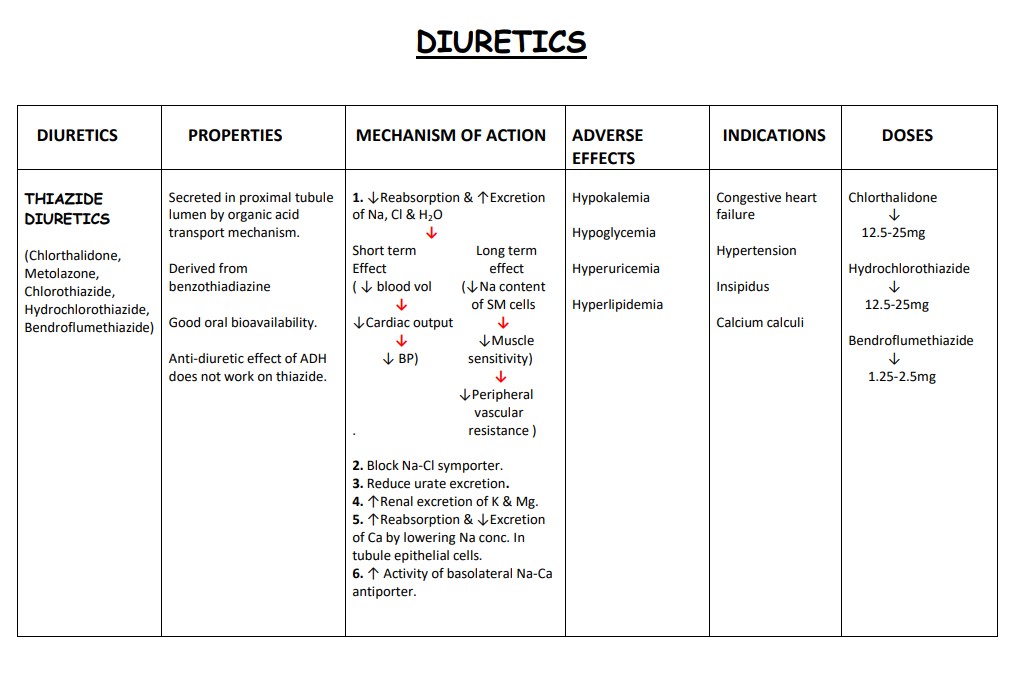The Basics of Diuretic Drugs (Grade A)
Summary:
This note summarises diuretics, focusing on their drug subclasses, properties, mechanism of action, adverse effects, indications, and doses.
The diuretic subclasses discussed include thiazide diuretics (such as Chlorthalidone and Hydrochlorothiazide), loop diuretics (such as Furosemide and Torsemide), potassium-sparing diuretics (such as Spironolactone and Amiloride), and osmotic diuretics (such as Mannitol and Glycerol). Carbonic anhydrase inhibitors (Acetazolamide and Dorzolamide) are also mentioned.
Thiazide diuretics work by reducing reabsorption and increasing the excretion of sodium, chloride, and water. They block the Na-Cl symporter and affect the excretion of urate and potassium. Thiazides are indicated for hypertension, heart failure, and calcium calculi.
Loop diuretics act on the loop of Henle and inhibit the Na/K/2Cl co-transport system, leading to the excretion of sodium, chloride, and water. They are commonly used in conditions like heart failure, hypertension, and edema.
Potassium-sparing diuretics include aldosterone antagonists (Spironolactone and Eplerenone) and epithelial sodium channel blockers (Amiloride and Triamterene). They prevent sodium reabsorption in the distal tubule and collecting duct. Potassium-sparing diuretics are indicated for conditions such as heart failure, hypertension, and hyperaldosteronism.
Osmotic diuretics, like Mannitol and Glycerol, increase osmotic pressure in plasma and promote diuresis by drawing water from the interstitial and transcellular fluid. They are used in congestive heart failure and hypotension, and to reduce cranial and intraocular pressure.
Excerpt:
The Basics of Diuretic Drugs
DIURETICS
|
DIURETICS |
PROPERTIES |
MECHANISM OF ACTION |
ADVERSE EFFECTS |
INDICATIONS |
DOSES |
|
THIAZIDE DIURETICS
(Chlorthalidone, Metolazone, Chlorothiazide, Hydrochlorothiazide, Bendroflumethiazide) |
Secreted in proximal tubule lumen by organic acid transport mechanism.
Derived from benzothiadiazine
Good oral bioavailability.
Anti-diuretic effect of ADH does not work on thiazide. |
1. ↓Reabsorption & ↑Excretion of Na, Cl & H2O ↓ Short term Long term Effect effect ( ↓ blood vol (↓Na content ↓ of SM cells ↓Cardiac output ↓ ↓ ↓Muscle ↓ BP) sensitivity) ↓ ↓Peripheral vascular . resistance )
2. Block Na-Cl symporter. 3. Reduce urate excretion. 4. ↑Renal excretion of K & Mg. 5. ↑Reabsorption & ↓Excretion of Ca by lowering Na conc. In tubule epithelial cells. 6. ↑ Activity of basolateral Na-Ca antiporter. |
Hypokalemia, Hypoglycemia, Hyperuricemia Hyperlipidemia |
Congestive heart failure
Hypertension Insipidus Calcium calculi |
Chlorthalidone ↓ 12.5-25mg
Hydrochlorothiazide ↓ 12.5-25mg
Bendroflumethiazide ↓ 1.25-2.5mg |


Reviews